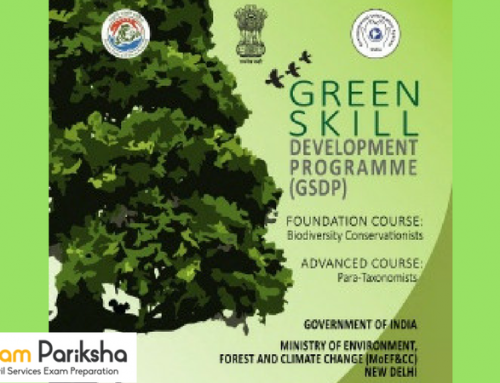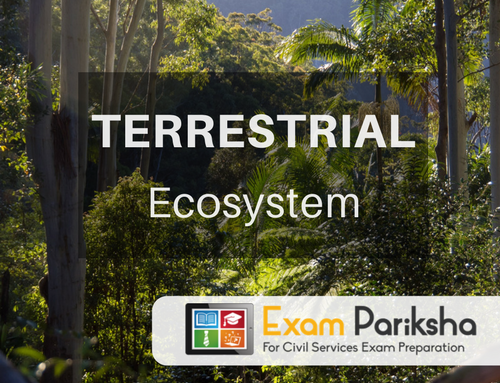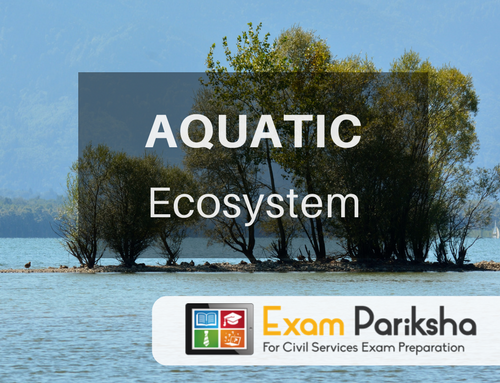The Term Ecology shows the Vital Relationship of a living organism with Each other and with their Environment. Scientists Found in 1868 and termed as Ecology later. Ecology is a Combinations of two Greek Words ‘Oikos’ & ‘Logos’ Which Means study of the Home Nature. As they are Very Helpful for use of Environmental Resources which includes Energy flow and cycling.
History of Ecology:
In Today’s World Every Person required to have Knowledge of its Environment How to Survive?
The Vedic Period of India such as the Vedas, the Samhita’s, the Brahmana’s and the Aranyankas-Upanishads shows much Evidence of Ecological Concepts.
The Carakasamhita and Susruta – Samhita which is an Indian Treatise Medicine shows People great understanding of Plant and Animal Ecology. Carakasamhita Contains an information that Air, land water and Seasons Were Indispensable for Life Which Polluted the Air and water which is injurious to Health.
Environment:
The Environment is the Collection of Living, non-living Components; which Surrounding an Organism. Whereas the Living Organism is Dependent on the food and Shelter to Live or for other Sources. Environment Contains Both Living Organisms “Biotic” and Non Living “Abiotic” Organism.
The concept of Environment:
The Interaction Between the Organism and Environment is highly Compliable.
No Organism Can Live Without Interacting Each other. Each and Everything with which we interact or we need for our Sustenance forms our Environment.
Let take the Example of Fish in the Pond:
- External Environment of Fish
- The Environment Consists of Abiotic Components such as Light, temperature, including the water in their nutrients, oxygen, other gases and other matter dissolved.
- The Biotic Environment Consists of Microscopic Organism Called Plankton as well as Aquatic Plant and Animals and Decomposers.
- Internal Environment of Fish
- It is Enclosed by Outer Body Surface.
- The Internal Environment is Relatively Stable as Compares to the External Environment.
- For Example, Marine Fish Can’t Survive in fresh Water Environment, it will be not able to Survive
Levels of Organisations in Ecology
Individual:
An organism is a Living Being that has the ability to Act or Function independently.it can be in any form plant, animal, Bacterium, fungi, etc.
They are Made of organs, organelles, or other parts that work together to carry out on the Various Processes of Life.
Population:
A group of Organism from same Species, Occupying a defined area of Specific Period of Time.
Here are Some Factors on Population:
- The Main Factor of Population Grow Is Birth and immigration.
- The Main Factor of Population Decrease Is Death and emigration.
The Relation Between the Number of Individuals of a Population and the Area they occupy is known as Density.
Community:
A Community is not Fixed or Rigid; Communities may be Large or Small.
For Example – A Grassland Community is Dominated by grasses, though it may contain herbs, shrubs, and trees along with animals and Different Species.
Types of Community:
- Major Community
These are Large in Size as well as Organised and Relatively Independent.
They depend on the Energy of Sun from Outside and independent on the inputs and Outputs from adjacent Communities.
Example: Tropical evergreen Forest north East.
- Minor Community
They are Neighbouring Communities and are often called Societies. They are aggregations within major Community and not therefore completely independent on energy and nutrient Dynamics.
Example: A Mat of Lichen on a Cow Dung Pad.
Ecosystem:
Ecosystem term Means a Structural and Functional Unit of Biosphere Which Consists of Living Beings and Physical Environment as they Interact and Exchange the Materials Between them. It is a Set of Complex Relationship among the Living Resources Habitats and Resident of their Area. An Ecosystem Consists Plants, trees, Fish, Birds, Micro-organism, water, soil etc.
They are Large in size and Elements but Functioning in own Unit. When Ecosystem is Healthy It Shows that all the Elements live in a Balance and they are Capable of Reproducing themselves. They can be Small as a tree or Can be Large as Entire Forest.
Components of Ecosystem:
Abiotic Components:
Abiotic Components Components Are Inorganic in nature and Non Living parts of the World. They include Number of Chemicals Such as Oxygen, Nitrogen, etc. And Physical Process such as Volcanoes, earthquakes, floods, Forest Fires, Climates, and Weather Conditions.
Here are Some Abiotic Factors:
- Energy:
Energy from the Sun is the Rich Sources for Maintenance of Life. While in case of plants, the Sun Directly Supplies the Necessary Energy. Animals Obtain the Energy from the Plant and Animals both.
- Rainfall:
Water Needs to all living Organism to Survive Without that there is no Life. It Helps to Regulate the Temperature of the Body. Water Bodies Form Habitat for Many Aquatic Plants and Animals.
- Temperature:
The Most Important Factor for the Environment is Temperature Which influences the Survive of all the Living Organism for the Toleration of Temperature and Humidity.
- Atmosphere:
An Atmosphere on Earth is Responsible for the Health Biosphere on the Earth. It’s made up of 21% of Oxygen,78 % of Nitrogen while 1% is other inert gases.
- Substratum:
Soil which Consists a Wide Variety of Microbes, Protozoa, Fungi and Small Animals thrive in it. Some Organism can be terrestrial and Aquatic. While Some Microbes Live in hot water vents under the Sea.
- Material:
Organic Compound Such as Proteins, Carbohydrates, Lipids, Humic Substances Is Formed Inorganic Compound on Decomposition. while the Other Such as Carbon, Carbon Dioxide, and ions of Various Metals Are Essential to Survive.
- Latitude and Altitude:
The Latitude Shows the Strong influence on Areas of Temperature as on Polar, Tropical, and Temperature. As the Altitude Increases the Air Becomes Colder and Drier, affecting wild Life as per the System of Ecosystem.
Biotic Components:
- Primary Producers: (Autotrophs)
They are Green Plants as Certain Bacteria and Algae. They Synthesise Carbohydrate from Simple Inorganic Raw Materials Like Carbon Dioxide and Water in Presence of Sunlight through the Process of Photosynthesis and Supply to the non-producers Directly. Producers are Basically herbaceous while, In Aquatic Ecosystem Producers of Various Species of Microscopic Algae.
- Consumers: (Heterotrophs)
They are incapable of Producing their Own Food. They Depend on Organic Food Which is derived from All the Plants and Animals of the Organism. They can be Derived in two Groups as Micro and Macro Consumers.
Micro:
Plants and Animals or Both are Categorised on the Basis of their Food Sources. Herbivores are the Primary Consumers Which Mainly they feed on Plants Such as Cow, Rabbit. Secondary Consumers depend on the Primary Consumers Such as Wolves. Omnivores the Organism Which Consume Both Plants and Animals Such as Man.
Micro Consumers.
Bacteria and Fungi Obtain the Energy by Decomposing dead organic Substances of Plants and Animals. Earthworm and Certain Soil Organism and Detritus Feeders can help in the Decomposition Matters and Are Called as Detrivores.
Ecotone:
Ecotone is the zone Junction of between two or More Ecosystems.
Example are: Grassland, Estuary and River Bank.
Characteristics of Ecotone:
- They are Narrow and Quite Wide.
- They are Intermediate to the Ecosystem and has a zone of Tension.
- They are Linear in Nature and Shows increase in Species Composition of one in Future Community
- Ecotones Contain Some Organism which is Entirely Different from Adjoining Communities.
- The Species and population density of some Species are Much Greater in Zone effect called edge Effect.
For Example: The Density of Birds is greater in the Mixed Habitat of the ecotone Between the Forrest and the Desert.
Niche:
The Unique Functional Role or Place of a Species in an Ecosystem is called Niche. It Plays the Most Important Role in our Ecosystem.
Types of Niche:
- Habitat Niche – Where they Live
- Food Niche – What is Eats and Decomposers & What Species It Compotes with
- Reproductive Niche – How and When It Reproduces.
- Physical Chemical Niche – Temperature, Land shape, Land Slope, Humidity & Other Requirements.
Biome:
A Biome is the Terrestrial Part of Divisible into Enormous Regions Are Known as Biome Which is Characterised by Climate, Vegetation, Animal Life and Different Types of Soil. As the Climate is the Source Control of the Biome and Abundance of Plants and Animals found in Each of them. Temperature and Precipitation Are Most Important factors of Biome.
Some Biome under the Region Are Classified as:
- Tundra
Region: Northern Most Region adjoining the Ice Bound Poles
- Taiga
Region: Northern Europe, Asia and North America,
- Temperate Deciduous Forest
Region: Central and Southern Europe and Eastern North America, Western China, Japan, New Zealand.
- Tropical Rain Forest:
Region: Tropical areas of the Equator which is Abound with Life.
- Savannah:
Region: The Most Extensive Part of Africa.
- Grassland:
Region: North America, Ukraine, which are Dominated by the Grasses.
- Desert:
Region: Continental Interiors with very Low and Sporadic rainfall with Low Humidity.
Aquatic Zones:
Aquatic systems are Not called Biomes the are Relatively Distinct with Plant and Animals Life. The Difference Between the Aquatic Zones due to Salinity and Levels of Dissolved Nutrients and Water Temperature.
Biosphere:
A Biosphere has a Narrow Layer on Earth as it is thick as the Skin. It is Highly integrated and Interacting Zone Comprising of Atmosphere, Hydrosphere, and Lithosphere. Life in the Lithosphere is Between 200 Meters to 600 Meters 20000 feet Above the Sea Level. The biosphere is Absent in North and South Poles, the Highest Mountains as well as in the Deepest oceans. The Biosphere survives from the Energy of the Sun and the Nutrients Necessary Are Air, water and Soil. This Same Cycle Recycled over and Over Again for Life to Continue.





